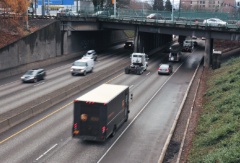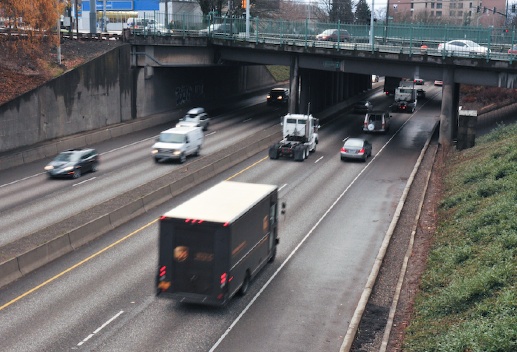
goes under NE Broadway.
(Photo © J. Maus)
I hope you’ve read my post yesterday about a report from ODOT on how they see the “problem” and potential “solutions” to bottlenecks along I-5 near the Broadway/Weidler interchange. This area is a key hub in Portland’s bikeway network: We must get this right.
With the N/NE Quadrant planning process kicking into high gear, this I-5 bottleneck issue — which has been studied by ODOT since the early 1980s — has found new life. Without a strong community voice about how to — or if we should — move forward, some of the shockingly highway-centric concepts in that report could gain traction.
That being said, I learned more about the report this morning from Steve Iwata, Planning Supervisor at the City of Portland Bureau of Planning and Sustainability (BPSS). Iwata is handling the Central City Plan for BPSS and he’s familiar with the report. Iwata confirmed that — contrary to my reporting on yesterday’s story — the concepts were actually developed in November 2007, but the report had remained an “internal working document” until being recently published to the web as part of the N/NE Quadrant planning process.
According to Iwata, the publication of these concepts was done to “Let people know we had done this work in the past but now we’re starting from scratch. There’s no official endorsement of any of the ideas.”
Iwata sees the report simply as a reference guide and that we are starting from a “blank slate” in figuring out how to (or if we should) fix the traffic issues on the freeway and surrounding streets. The report’s authors echo this sentiment in their preface (written last month), “…The following concepts are starting points – not an end.”
Looking at the four concepts, it’s hard for me to think we’re starting from a “blank slate.” “Starting points” — no matter how innocent they might sound — can have a huge impact on what solutions are ultimately arrived at. If we begin this discussion by looking at massive highway widening, displacement of buildings, new freeway ramps, and so on, are we really starting from a blank slate?
When I expressed to Iwata my concerns about the dangers inherent in making this report a “starting point” he said, “Your concerns are reflected by several members of our advisory group… Several people are a little suspicious… They see what’s going on with the CRC (Columbia River Crossing)…” [See the members of the Stakeholder Advisory Group here.]
Critics of the CRC are waging a fierce battle in large part because of the way the problem was initially defined. The definition of the problem and the narrative that planners set in the beginning have limited what solutions can be considered; and, some say, favor the solutions the DOTs have wanted to pursue all along.
Iwata says that he’s confident in the City’s relationship with ODOT staff on this project and that they’re approaching this from a community-based, “bottom-up” style as opposed to the more “top-down” style of ODOT’s CRC project staff.
Even with Iwata’s somewhat reassuring words, ODOT considers any slowdown on a major freeway to be an urgent problem and they’ll take any opportunity to fix it. How they fix this particular bottleneck remains to be seen; but if they choose the 1950s “Just make it wider!” approach, you can’t say I didn’t try to warn you.

